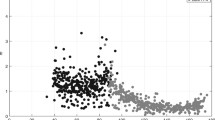Summary
The temperature T of a black or gray body orbiting the Sun can be expressed in terms of spherical harmonics in latitude and longitude, its Keplerian orbital elements, and a variable describing rotation about its axis. Assuming that the Earth is a black or gray body without thermal inertia, the resulting equation for T exhibits previously unrecognized odd-degree zonal terms dubbed “Seversmith psychroterms.” They cause a hemispheric temperature difference which depends upon e sin ω S , where e is the orbital eccentricity and ω S is the Sun’s argument of perigee measured in an Earth-centered frame. The hemisphere containing perihelion is the cooler. For a gray body with the Earth’s average albedo of 0.3, an emissivity of unity, and an obliquity of 23.5°, the pole-to-pole temperature difference for the combined first and third degree spherical harmonic psychroterms can reach 3.4 K for the present eccentricity of 0.016, and 12.9 K for the maximum eccentricity of 0.06. While a thermally inertia-less black or gray body with boiling hot subsolar points and nights at absolute zero are poor models for the Earth, the Seversmith psychroterms will survive in more realistic models (although with smaller amplitudes) because the Earth radiates nonlinearly in T. The psychroterms acts in the direction opposite to the Milankovitch precession index, which also depends on e sin ω S : by warming the cool northern summers, the psychroterms make it harder for the traditional Milankovitch mechanism to operate. The Seversmith psychroterms could in fact be responsible for the ice sheets that cycle with e sin ω S , instead of the Milankovitch mechanism. By cooling the southern hemisphere for thousands of years when perihelion is in the south, the psychroterms may somehow cause the southern hemisphere to control the northern ice sheets associated with the 23 kyr and 19 kyr periods (kyr = 103 years), possibly through ice-albedo feedback in the sea ice surrounding Antarctica. Two other unexpected features besides the psychroterms are: while the average insolation increases with increasing e, the average temperature of the Earth paradoxically decreases; and the equator-to-pole temperature difference of 21 K on a gray body with an albedo equal to 0.3 and an emissivity of unity is actually smaller than the observed difference of 28 K on the real Earth.
Similar content being viewed by others
Author information
Authors and Affiliations
Rights and permissions
About this article
Cite this article
Rubincam, D. Black body temperature, orbital elements, the Milankovitch precession index, and the Seversmith psychroterms. Theor Appl Climatol 79, 111–131 (2004). https://doi.org/10.1007/s00704-004-0056-5
Received:
Revised:
Accepted:
Published:
Issue Date:
DOI: https://doi.org/10.1007/s00704-004-0056-5




